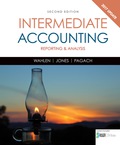
Concept explainers
1.
Prepare a schedule of Corporation P’s compensation computation for its compensatory share option plan for 2013.
1.
Explanation of Solution
Share option plan: This is an option given to an employee to buy a certain number of shares of stock of the company at a pre-determined price during certain period of time.
Prepare a schedule of Corporation P’s compensation computation for its compensatory share option plan for 2013:
| Particulars | 2013 | 2014 | 2015 |
| Total compensated cost | $119,000 | $119,000 | $120,400 (1) |
| Fraction of service period expired | 1/3 | 1/3 | 1/3 |
| Compensation expense | $39,667 | $79,333 | $120,400 |
| Previously recognized compensation expense | (0) | (39,667) | ($79,333) |
| Current compensation expense | $39,667 | $39,666 | $41,067 |
Table (1)
Working note 1: Compute the total compensation cost for the year 2015:
2.
Prepare a memorandum entry on the grant date and
2.
Explanation of Solution
Prepare a memorandum entry on the grant date:
Memorandum entry: On January 1, 2013, the company granted compensatory share options to 50 executives. The plan allows each executive to exercise 200options to acquire the same number of shares of company’s common stock at an exercise price of $30 per share and vest at the end of service period of 3 years. The estimated fair value of the options expected to be exercised is $119,000.
Working note 2: Compute the total compensation cost of options for the year 2013.
Journalize compensation expense for share options for the year 2013 in the books of Company P:
| Date | Account title and Explanation | Post Ref. |
Debit ($) |
Credit ($) |
| 2013 | Compensation expense | $39,667 | ||
| Paid-in capital from share options | $39,667 | |||
| (To record share options) |
Table (2)
- Compensation Expense is an expense account. Expenses and losses decrease Equity account. Therefore, debit Compensation Expense account with $39,667.
- Paid-in Capital from Share Options is a shareholders’ equity account. Since share options are granted, company’s stock amount has increased. Therefore, credit Paid-in Capital from Share Options account with $39,667.
Journalize compensation expense for share options for the year 2014 in the books of Company P:
| Date | Account title and Explanation | Post Ref. |
Debit ($) |
Credit ($) |
| 2014 | Compensation expense | $39,667 | ||
| Paid-in capital from share options | $39,667 | |||
| (To record share options) |
Table (3)
- Compensation Expense is an expense account. Expenses and losses decrease Equity account. Therefore, debit Compensation Expense account with $39,667.
- Paid-in Capital from Share Options is a shareholders’ equity account. Since share options are granted, company’s stock amount has increased. Therefore, credit Paid-in Capital from Share Options account with $39,667.
Journalize compensation expense for share options for the year 2015 in the books of Company P:
| Date | Account title and Explanation | Post Ref. |
Debit ($) |
Credit ($) |
| 2015 | Compensation expense | $39,667 | ||
| Paid-in capital from share options | $39,667 | |||
| (To record share options) |
Table (4)
- Compensation Expense is an expense account. Expenses and losses decrease Equity account. Therefore, debit Compensation Expense account with $39,667.
- Paid-in Capital from Share Options is a shareholders’ equity account. Since share options are granted, company’s stock amount has increased. Therefore, credit Paid-in Capital from Share Options account with $39,667.
Journalize compensation expense for share options for the year 2016 in the books of Company P:
| Date | Account title and Explanation | Post Ref. |
Debit ($) |
Credit ($) |
| 2016 | Cash | $48,000 | ||
| Paid-in capital from share options | $22,400 | |||
| Common stock, $5 par | $3,200 | |||
| Additional paid-in capital | $67,200 | |||
| (To record share options) |
Table (5)
- Cash is an asset account. Since share options are exercised and shares are purchased for cash, cash is received. Therefore, debit Cash account with $48,000.
- Paid-in Capital from Share Options is a shareholders’ equity account. Since share options which are granted are exercised, the entry is reversed and cancelled for options exercised. Therefore, debit Paid-in Capital from Share Options account with $22,400.
- Common Stock is a shareholders’ equity account. Since share options which are granted are exercised and shares are sold, common stock amount increased. Therefore, credit Common Stock account with $3,200.
- Additional Paid-in Capital on Common Stock is a shareholders’ equity account. Since share options which are granted are exercised and shares are sold for more than par value, additional capital amount increased. Therefore, credit Additional Paid-in Capital on Common Stock account with $67,200.
Working Note 3: Compute cash received by Company P.
Working Note 4: Compute the paid-in capital of stock options amount.
Working Note 5: Compute the common stock amount.
Working Note 6: Compute the additional paid-in capital amount.
Want to see more full solutions like this?
Chapter 15 Solutions
EBK INTERMEDIATE ACCOUNTING: REPORTING
 Intermediate Accounting: Reporting And AnalysisAccountingISBN:9781337788281Author:James M. Wahlen, Jefferson P. Jones, Donald PagachPublisher:Cengage Learning
Intermediate Accounting: Reporting And AnalysisAccountingISBN:9781337788281Author:James M. Wahlen, Jefferson P. Jones, Donald PagachPublisher:Cengage Learning

